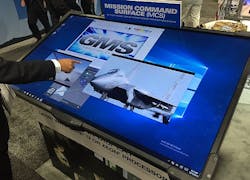Electro-optical display technology is emerging that will enable surface warship combat information centers to show up-to-date data on video walls or on ship chart tables without the use of projectors. These displays also are rugged enough to survive torturous barge testing without failures.
The same advantages could go to forward-deployed command posts, where large rugged displays could cover the entire walls of tactical operations center tents.
One such technology was on display this week at the Association of the U.S. Army (AUSA) conference and trade show in Washington. General Micro Systems (GMS) Inc. in Rancho Cucamonga, Calif., made the public debut of the company's RuggedView smart displays that are as large as 6 by 3 feet that can withstand the stress of lying flat like a table.
Related: Rugged display for planes, helicopters, and ground vehicles introduced by Curtiss-Wright
Other rugged displays that come in sizes as large as tables come from companies like Esterline Codis in Duluth, Ga., and Navtor AS in Egersund, Norway.
The GMS UHD65W-1102/301 rugged display relies on infrared touch-screen technology with embedded Intel Core i7 or Xeon microprocessors and rugged data storage that can call up schematics, maps and charts, video, images, or map overlays with battlefield information.
Think of a tablet computer the size of a coffee table, and you have the largest of the GMS RuggedView displays. The displays can withstand barge testing while lying flat, while other large displays would collapse of their own weight under such harsh conditions, says GMS CEO Ben Sharfi.
Barge testing involves explosives detonated near a floating barge to simulate the intense shock of a torpedo hit or sea mine explosion. It is among the most punishing environmental tests the Navy has.
Related: Rugged display for dirty, wet, and hostile operating environments introduced by Stealth
Sharfi says his GMS engineers start with a 64.5-inch display from Sony Corp., then essentially dismantle the display and ruggedize it for military applications -- including GMS rugged single-board computer technology. The finished display is less than 4 inches thick and weighs 80 to 90 pounds, Sharfi says.
Not only can its embedded microprocessor render high-resolution graphics, but it also can help stitch several of these large displays into one display as large as a wall that is a candidate for the combat information centers of surface warships, as well as deployed military command posts.
The GMS RuggedView displays range in size from 10.4-inch to 64.5 inches, and can be combined into even larger displays.
The AUSA show continues this week in Washington through Wednesday.




